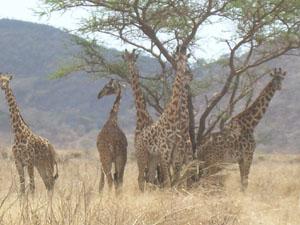Alexander Lobora
Other projects
The project seeks to use remote cameras to explore the distribution of cryptic and nocturnal mammals in Mkomazi National Park and ensure long-term monitoring for the species.

Camera setting.
Located in East Africa, Tanzania ranks 5th in Africa in mammal biodiversity, with the Serengeti ecosystem alone boasting the highest diversity of ungulates in the world and the greatest abundance in Africa. It hosts some of the largest protected areas in the world, demonstrating its commitment to conservation and is a signatory to the CBD and CITES. However, despite its biological richness, it remains one of the poorest countries in the world and relies on support from outside to fulfil its obligations to the convention.

Giraffe.
Mkomazi National Park is located in north eastern part of Tanzania adjoining Tsavo National Park in Kenya providing yet another trans-boundary ecosystem. The park has an area of approximately 3,245km2 and was first gazetted as a game reserve in 1951 and later elevated to a national park in 2008. The park is known to be rich in biodiversity harbouring several species with limited range elsewhere in Tanzania. For these reasons, the area has been earmarked as one of the priority areas for research in the country by the Tanzania Wildlife Research Agenda. Whilst there is a body of work on the biodiversity of the area, there has been no systematic survey for cryptic and nocturnal mammal species in the area and hence the project seeks to use recent developments in camera trapping survey techniques and analysis to assess cryptic and nocturnal mammals and their spatial distribution in the area, establish the park’s mammal geo-database, sensitise communities surrounding the park to participate in conservation activities, develop a comprehensive species list of the park hence addressing information needs identified by the new National Mammal Conservation Action Plan for Tanzania, increasing the robustness of future conservation plans.

Zebra.
Overall, the outputs emanating from this project will be very helpful in providing information to wildlife managers and the scientific community. The database to be developed in this project for example will be a useful platform in expediting monitoring of all mammal species in the area and will aid in establishing baselines that can be used to assess future trends, identify major threats, plan responses to threats and assess effects of conservation actions. Furthermore, the platform is important for researchers as well as wildlife managers who desperately need it for setting conservation priorities. If species distribution is well monitored, it can provide information on range extension or contraction and hence wildlife managers can design appropriate conservation interventions.